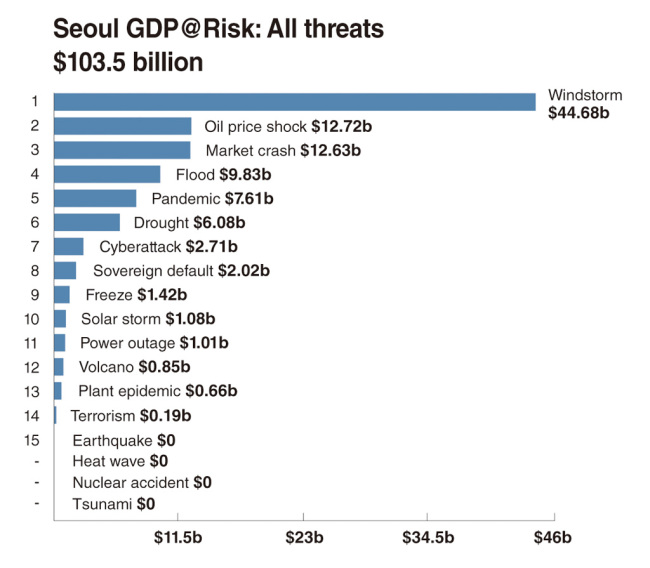Seoul stands to see the third biggest economic loss globally -- approximately $103.5 billion -- if faced with natural catastrophes and man-made economic shocks between the period of 2015 and 2025, a report showed Monday.
Based on the original research by the Cambridge Center for Risk Studies at the University of Cambridge Judge Business School, UK insurance firm Lloyds’ City Risk Index 2015-2025 listed 301 major cities in terms of expected loss to a selected location’s economic output -- average annual gross domestic product -- from 18 types of natural and man-made threats.
The report showed that Taipei topped the list with a total GDP at risk calculated at $181.20 billion, followed by Tokyo with $153.28 billion.
Based on the original research by the Cambridge Center for Risk Studies at the University of Cambridge Judge Business School, UK insurance firm Lloyds’ City Risk Index 2015-2025 listed 301 major cities in terms of expected loss to a selected location’s economic output -- average annual gross domestic product -- from 18 types of natural and man-made threats.
The report showed that Taipei topped the list with a total GDP at risk calculated at $181.20 billion, followed by Tokyo with $153.28 billion.

Seoul was ranked third and was one of four Asian cities that topped the Index’s total GDP at risk rankings, followed by Manila, New York and Los Angeles.
According to the index, Busan showed $20.45 billion of total GDP at risk, followed by Daegu ($13.50 billion), Incheon ($10.59 billion), Daejeon ($9.86 billion) and Gwangju ($8.66 billion).
The report said the South Korean capital could be hit hard by a windstorm, mainly due to its geographical location in the northwest Pacific typhoon belt.
By threat type, a windstorm was the highest risk factor for Seoul, with potential economic loss calculated at $44.68 billion, followed by an oil price shock ($12.72 billion), market crash ($12.63 billion), flood ($9.83 billion), pandemic ($7.61 billion) and drought ($6.08 billion).
Among 301 cities, Seoul was also the third most exposed city to potential losses from natural threats, including flood and drought. Seoul showed the world’s highest exposure to drought, due to the fact that the Korean Peninsula suffered its worst drought in the past century in 2012.
But despite South Korea’s strongest earthquake last week, the report calculated the potential losses from earthquakes at zero.
In terms of man-made economic threats, the report said that as South Korea lacks oil and gas resources, Seoul was vulnerable to a market crash and an oil price shock, placing the country in third for highest exposure to an oil price shock in the world.
The report added that one-third of Seoul’s total exposure to economic threats come from emerging threats, including pandemic, cyberattacks and solar storms.
“The nature of these threats is changing, too. Certain extreme weather events linked to climate change are increasing in severity and frequency. Man-made threats, such as cyberattacks and market crash, are increasingly significant as companies expand into new markets and territories,” said Inga Beale, CEO of Lloyd’s.
“(In that sense, the report) is a wake-up call to us all, as disasters that have occurred in the past are likely to do so again in the future,” Beale added in the report.
By Kim Da-sol (ddd@heraldcorp.com)
According to the index, Busan showed $20.45 billion of total GDP at risk, followed by Daegu ($13.50 billion), Incheon ($10.59 billion), Daejeon ($9.86 billion) and Gwangju ($8.66 billion).
The report said the South Korean capital could be hit hard by a windstorm, mainly due to its geographical location in the northwest Pacific typhoon belt.
By threat type, a windstorm was the highest risk factor for Seoul, with potential economic loss calculated at $44.68 billion, followed by an oil price shock ($12.72 billion), market crash ($12.63 billion), flood ($9.83 billion), pandemic ($7.61 billion) and drought ($6.08 billion).
Among 301 cities, Seoul was also the third most exposed city to potential losses from natural threats, including flood and drought. Seoul showed the world’s highest exposure to drought, due to the fact that the Korean Peninsula suffered its worst drought in the past century in 2012.
But despite South Korea’s strongest earthquake last week, the report calculated the potential losses from earthquakes at zero.
In terms of man-made economic threats, the report said that as South Korea lacks oil and gas resources, Seoul was vulnerable to a market crash and an oil price shock, placing the country in third for highest exposure to an oil price shock in the world.
The report added that one-third of Seoul’s total exposure to economic threats come from emerging threats, including pandemic, cyberattacks and solar storms.
“The nature of these threats is changing, too. Certain extreme weather events linked to climate change are increasing in severity and frequency. Man-made threats, such as cyberattacks and market crash, are increasingly significant as companies expand into new markets and territories,” said Inga Beale, CEO of Lloyd’s.
“(In that sense, the report) is a wake-up call to us all, as disasters that have occurred in the past are likely to do so again in the future,” Beale added in the report.
By Kim Da-sol (ddd@heraldcorp.com)








![[Today’s K-pop] BTS pop-up event to come to Seoul](http://res.heraldm.com/phpwas/restmb_idxmake.php?idx=644&simg=/content/image/2024/04/17/20240417050734_0.jpg&u=)

![[Graphic News] More Koreans say they plan long-distance trips this year](http://res.heraldm.com/phpwas/restmb_idxmake.php?idx=644&simg=/content/image/2024/04/17/20240417050828_0.gif&u=)






![[KH Explains] Hyundai's full hybrid edge to pay off amid slow transition to pure EVs](http://res.heraldm.com/phpwas/restmb_idxmake.php?idx=652&simg=/content/image/2024/04/18/20240418050645_0.jpg&u=20240419100350)

